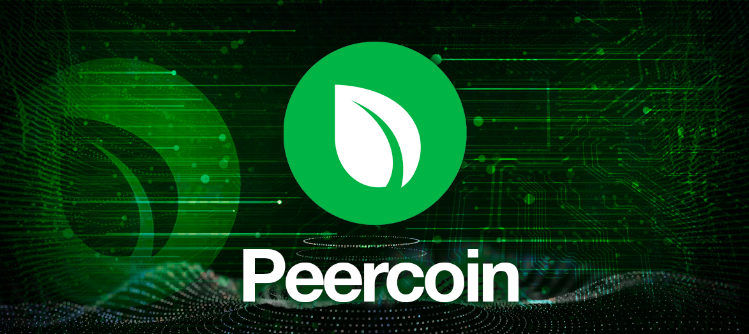Peercoin: pioneering sustainability in cryptocurrencies
Peercoin, also known as PPC or PPCoin, is an innovative cryptocurrency that emerged in 2012. It distinguished itself in the digital currency landscape for its novel implementation of a hybrid proof-of-stake (PoS) and proof-of-work (PoW). system.
This innovative approach aimed to address some of the problems inherent in existing cryptocurrencies, particularly around power consumption and security. As a forerunner in the crypto space, Peercoin’s philosophy focuses on sustainability, decentralization and long-term scalability.
Peercoin Innovations
Peercoin has been a pioneer in the world of cryptocurrencies, introducing innovative concepts that have significantly influenced the digital currency landscape. This section delves into the key innovations that distinguish Peercoin, highlighting its unique approach to blockchain technology and the cryptocurrency economy.
Hybrid proof-of-work and proof-of-participation model
Peercoin’s most notable innovation is its pioneering hybrid system that combines proof-of-work (PoW) and proof-of-stake (PoS) mechanisms. This hybrid model was a first in the cryptocurrency world, a creative solution to address some of the limitations of the traditional PoW system used by cryptocurrencies such as Bitcoin.
- PoW component: initially, Peercoin used PoW, similar to Bitcoin, for initial coin distribution. This method was fundamental to ensure a fair and widespread distribution of coins, essential to establish a decentralized network.
- PoS Transition: The truly revolutionary aspect of Peercoin is its PoS system. Unlike PoW, miners use significant computational power to solve complex problems; PoS relies on coin ownership to protect the network. Users who own coins can participate in the network’s consensus mechanism and earn rewards for their contribution. This method drastically reduces the power consumption typically associated with cryptocurrency mining.
Improved security and lower energy consumption
One of the main advantages of Peercoin’s hybrid model is the increased security and sustainability it offers:
- Security through proof of stake: the PoS component adds a layer of security to the Peercoin network. Mitigates the risk of 51% of attacks that are more feasible in pure PoW systems, where network control depends on computational power.
- Energy efficiency: PoS does not require the intensive computational work that PoW does, making Peercoin a more energy-efficient and environmentally friendly cryptocurrency. This approach addresses one of the most important criticisms of cryptocurrencies: their environmental impact.
Fair and equitable distribution of currencies
Peercoin’s design also focuses on the equitable distribution of the currency, a vital aspect for the long-term stability and decentralization of the currency:
- Balanced initial distribution: the initial phase of PoW allowed for a wider and more equitable distribution of Peercoin, avoiding the concentration of wealth and power among a few early adopters or large-scale miners.
These innovations position Peercoin not only as a cryptocurrency but as a sustainable and secure digital currency model. Its pioneering hybrid system, emphasis on energy efficiency and commitment to fair distribution have set benchmarks in the cryptocurrency world, reflecting Peercoin’s role as a visionary in digital currencies.
Key features of Peercoin
In the diversity of cryptocurrencies, Peercoin is distinguished by unique features that address common challenges in digital currency. Focusing on sustainability, security and decentralization, Peercoin presents innovative solutions in the crypto space. These are the unique characteristics that define Peercoin:
- Resistance to centralization: a common problem with cryptocurrencies, particularly those that rely solely on PoW, is the risk of mining centralization, where a small group of miners could potentially dominate the network. The PoS element of Peercoin combats this by making it less profitable for a single entity to control most of the mining power, thus maintaining a more decentralized network.
- Controlled inflation and economic stability: Peercoin has a unique approach to inflation. The inflation rate is designed to be minimal and directly linked to network usage, creating a stable economic environment. The fixed transaction fee, which is destroyed rather than distributed, also helps control inflation, ensuring the long-term viability of the currency.
- User reward system: users who participate in the PoS process are rewarded with an annual return of 1% on their participation. This encourages users to hold on to their coins, providing stability to the network and incentivizing long-term investment, which is crucial to the steady growth and health of the Peercoin ecosystem.
- Long-term scalability: Designed with the future in mind, Peercoin addresses critical issues such as blockchain inflation and transaction fee structures, ensuring its long-term viability and scalability.

The Peercoin economic model
Peercoin, as a pioneering cryptocurrency, introduces an economic model as innovative as its technical underpinnings. This model is characterized by its focus on inflation, rewards and transaction fees, designed to promote long-term stability and sustainability in the network. The following provides an in-depth look at the critical components of the Peercoin economic model:
- Controlled inflation mechanism: Peercoin adopts a controlled inflation model, unlike many cryptocurrencies with a fixed supply limit. This approach ensures that the supply of currencies grows along with demand, avoiding the dangers of deflation or extreme inflation. The inflation rate is intrinsically linked to network activity, balancing the needs of the ecosystem with the value of the currency.
- Proof-of-stake rewards: Central to Peercoin’s economic model is its proof-of-stake (PoS) system, which rewards users for holding coins. Unlike proof-of-work (PoW) systems, where miners receive rewards for solving complex mathematical problems, PoS participants in Peercoin earn an annual return of 1% on their participation. This incentivizes users to hold on to their currencies, promoting network stability and a longer-term investment approach. It is a system that rewards participation and commitment, aligning the interests of individual users with the health of the network as a whole.
- Fixed transaction fees: Peercoin implements a fixed transaction fee policy. Unlike many other cryptocurrencies, where market dynamics determine fees and can fluctuate wildly, Peercoin fees are set at a fixed rate. This predictability in transaction costs adds a layer of stability to the network, making it easier for users to understand and interact with the system. More interestingly, these transaction fees are burned and permanently removed from circulation. This unique approach serves as a deflationary mechanism, counteracts inflation caused by the PoS reward system and helps maintain a balanced economy.
- Long-term economic sustainability: the combination of controlled inflation, reward for holding and a fixed and burned transaction fee creates an economic environment conducive to long-term sustainability. This model is designed to encourage steady growth, discourage speculative fluctuations and promote the overall health of the Peercoin network.
The Peercoin economic model represents a thoughtful balance between growth and stability. It is an approach that reflects the spirit of cryptocurrency: to provide a sustainable, decentralized alternative to traditional fiat currencies.
By aligning incentives for users to contribute to the health of the network, Peercoin distinguishes itself in the crowded field of digital currencies.
Comparison of Peercoin with other cryptocurrencies
Understanding how Peercoin stands out in digital currencies requires a comparative look at its characteristics with other prominent cryptocurrencies. Peercoin’s unique approach, with its hybrid proof-of-work (PoW) and proof-of-stake (PoS) model, offers distinct advantages and differences compared to other major players such as Bitcoin, Ethereum and newer PoS-based cryptocurrencies such as Cardano.
Bitcoin
- PoW model: Bitcoin is based entirely on a PoW system which, while secure, is very energy intensive due to the computational power required for mining.
- Energy consumption: the Bitcoin mining process consumes a significant amount of electricity, which raises environmental concerns.
- Centralization risk: the increasing difficulty and cost of mining Bitcoin has led to the centralization of mining operations into large farms and pools.
Ethereum
- Transition to PoS: Ethereum, initially a PoW-based system like Bitcoin, is transitioning to a PoS system to reduce its environmental impact and improve scalability.
- Smart contract capability: the key feature of Ethereum is its robust smart contract functionality, which Peercoin does not natively support.
- Larger ecosystem: Ethereum has a larger ecosystem with numerous decentralized applications (dApps) and a strong developer community.
Cardano
- Pure PoS system: Cardano uses a PoS system exclusively, focusing on providing a more energy efficient and scalable platform.
- Research-driven approach: it is known for its research-driven, peer-reviewed approach to development.
- Advanced smart contract capabilities: Cardano supports advanced smart contract capabilities and aims to provide more secure and scalable dApps.
Comparison chart: Peercoin with other cryptocurrencies
| Feature/Cryptocurrency | Peercoin | Bitcoin | Ethereum | Cardano |
| Consensus mechanism | Hybrid PoW and PoS | Prisoner of war | PoW (transition to PoS) | Point of Sale |
| Energy efficiency | High (due to PoS) | Low (due to PoW) | Moderate (improving with PoS) | High |
| Environmental impact | Under | High | Moderate | Under |
| Risk of centralization | Under | High | Moderate | Under |
| Inflation/supply control | Controlled inflation | Limited supply | Limited supply | Controlled inflation |
| Smart contracts | Not natively supported | Not supported | Supported | Supported |
| Main use case | Digital Currency | Digital currency, store of value | Smart contracts, dApps | Smart contracts, dApps |
| Developer community | Menor | Larger | Grande | Growing |
| Transaction fee structure | Fixed rate, burned | Variable rate, paid to miners | Variable rate, paid to miners | Low, paid to bettors |
This table and the discussion above illustrate how Peercoin offers an interesting alternative to cryptocurrencies with its sustainable approach and hybrid model.
While it may not have the extensive ecosystem of Ethereum or the same level of adoption as Bitcoin, its focus on environmental friendliness and lower risk of centralization make it a worthy competitor in the market.

The future of Peercoin
As we look to the digital currency horizon, Peercoin stands as a visionary in the field, demonstrating significant potential to shape the future cryptocurrency landscape.
With its innovative combination of proof-of-stake (PoS) and proof-of-work (PoW) systems, Peercoin has laid the groundwork for a more sustainable and efficient approach to digital currency. This section of the article explores possible future developments and the impact of Peercoin in the ever-evolving world of cryptocurrencies.
Sustainability and Environmental Awareness
In an era where environmental impact is increasingly under scrutiny, Peercoin’s energy-efficient model positions it as a pioneer for environmentally conscious investors and users. As the global community becomes more aware of the carbon footprint of digital activities, including cryptocurrency mining, Peercoin’s reduced reliance on energy-intensive PoW mining makes it a delightful alternative. From this environmental angle, Peercoin could gain ground as the preferred choice for those looking to align their digital asset portfolios with their green values.
Decentralized Finance Innovation (DeFi)
Peercoin’s future is also very promising in the burgeoning field of decentralized finance. With its secure and scalable network, Peercoin can support various DeFi applications. The PoS element of Peercoin not only ensures a more energy-efficient operation, but also contributes to a stable and decentralized financial ecosystem. As DeFi continues to grow, incorporating more complex financial instruments and services, the robust and efficient nature of the Peercoin blockchain could make it an ideal platform for DeFi’s innovation and development.
Adaptability and long-term viability
Peercoin’s focus on long-term scalability and its adaptive economic model are critical to its future success. Adapting to changing technological and economic conditions will be crucial as the cryptocurrency market matures. Peercoin’s combination of PoW and PoS provides a unique balance that can be adjusted to meet future challenges and demands. This adaptability, coupled with its focus on sustainability, gives Peercoin a competitive advantage in the long-term landscape of digital currencies.
Community and Development
Peercoin’s future growth is also intrinsically tied to its community and ongoing development efforts. A strong, active community and a commitment to continuous improvement and innovation are vital to the success of any cryptocurrency. As Peercoin continues to evolve, fostering a vibrant community and staying on the cutting edge of blockchain technology will be crucial to maintaining its relevance and influence in cryptocurrencies.
Peercoin’s future is on the cusp of significant growth and impact. Its sustainable model, adaptability and potential in the DeFi space position it as a cryptocurrency with a promising future, ready to meet the changing demands of the digital age.
The bottom line
This pioneering digital currency introduced a hybrid proof-of-stake (PoS) and proof-of-work (PoW) system. This article comprehensively explores how Peercoin distinguishes itself in the cryptocurrency arena, emphasizing its commitment to energy efficiency, security and decentralized governance.
Innovative hybrid system: Peercoin emerged as the first cryptocurrency to implement a PoS system alongside the traditional PoW mechanism. This hybrid model significantly reduces the environmental impact of mining, a critical concern in the age of digital currencies. By reducing reliance on energy-intensive mining practices, Peercoin presents a more sustainable and environmentally friendly approach to protecting its network.
Improved security and fair distribution: combining PoS with PoW in Peercoin improves network security, particularly against vulnerabilities in pure PoW systems, such as 51% attacks. In addition, the initial PoW phase facilitated a fairer distribution of coins by addressing the problem of early adopters or prominent stakeholders dominating the network, a common challenge in PoS-only based cryptocurrencies.
Peercoin characteristics and economic model: Peercoin has resistance to centralization, a focus on long-term scalability and a unique economic model. These features underpin the viability of Peercoin as a digital currency designed for the future. In particular, its fixed transaction fee model, where fees are burned rather than awarded to miners or stakeholders, helps control inflation and contributes to the overall economic stability of the network.
Comparison with other cryptocurrencies: the Peercoin approach contrasts with major cryptocurrencies such as Bitcoin and Ethereum, which rely heavily on PoW. While these leading currencies face issues related to energy consumption, Peercoin’s hybrid model stands out as a more sustainable option. Compared to purely PoS-based cryptocurrencies such as Nxt and Cardano, the Peercoin model offers enhanced security and a balanced distribution mechanism.
The future outlook: going forward, Peercoin’s alignment with environmental sustainability positions it favorably in a world increasingly concerned about the ecological impacts of technology. Its potential in the burgeoning field of decentralized finance (DeFi) also underscores its relevance and adaptability in the changing cryptocurrency landscape.
Peercoin as a pioneering force in digital currencies, leading the way towards a more sustainable, secure and equitable cryptocurrency ecosystem. Its innovative approach to blockchain technology addresses current environmental concerns and paves the way for future advances in this field.
